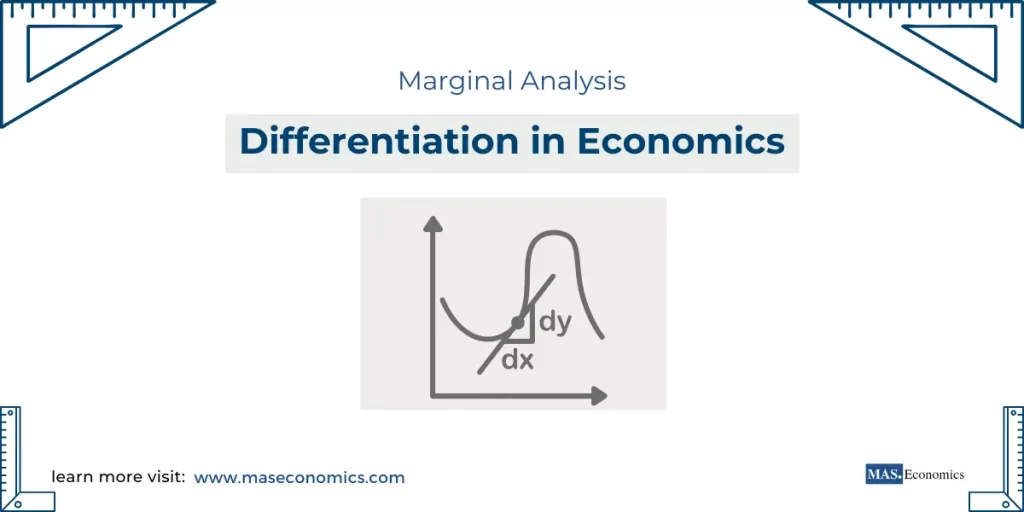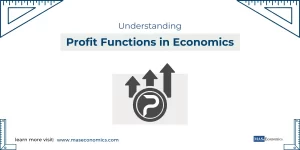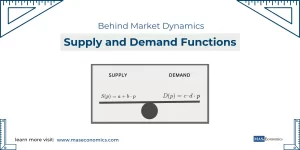Differentiation is a fundamental concept in calculus that plays a crucial role in economics, especially when analyzing how economic variables change over time. The ability to quantify how changes in input affect outcomes allows economists to make more informed decisions. In particular, marginal analysis uses differentiation to understand the rate of change in cost, revenue, or utility, which is essential for determining the optimal level of production or pricing.
What Is Differentiation?
Differentiation is the process of calculating the derivative of a function. A derivative represents the rate of change of one variable concerning another. In the context of economics, differentiation helps to understand how economic variables like cost, revenue, and demand change in response to changes in other variables such as price or production quantity.
Mathematically, the first derivative of a function provides information about the slope of the curve representing that function, which in economic terms often translates to marginal values—such as marginal cost, marginal revenue, or marginal utility.
The Difference Quotient
Before diving into differentiation, it’s useful to understand the concept of the difference quotient, which gives us the average rate of change of a function over an interval. In mathematical terms, the difference quotient for a function \( f(x) \) between two points, \( x_0 \) and \( x_1 \), is given by:
\( \frac{f(x_1) – f(x_0)}{x_1 – x_0} \)
This ratio provides a measure of how the function changes over the interval between \( x_0 \) and \( x_1 \). However, in economic analysis, we are often interested in the rate of change at a specific point rather than over an interval. This is where the derivative comes into play.
The Derivative and Marginal Analysis
The derivative of a function \( f(x) \) represents the instantaneous rate of change of the function at any given point. It is obtained by taking the limit of the difference quotient as the interval approaches zero:
\( f'(x) = \lim_{\Delta x \to 0} \frac{f(x + \Delta x) – f(x)}{\Delta x} \)
In economic terms, the derivative is often used to calculate marginal cost, marginal revenue, or marginal utility. For example:
-
Marginal Cost (MC) is the additional cost incurred by producing one more unit of a good. If the
cost function is given by \( C(x) \), then the marginal cost is the derivative of the cost function:
\( MC(x) = C'(x) \)
-
Marginal Revenue (MR) is the additional revenue gained from selling one more unit of a product.
If the revenue function is \( R(x) \), then the marginal revenue is given by:
\( MR(x) = R'(x) \)
These marginal values are crucial for firms as they help determine the optimal level of production, i.e., the point at which marginal cost equals marginal revenue.
Practical Example: Calculating Marginal Cost
Suppose a company’s cost function is given by:
\( C(x) = 500 + 20x + 3x^2 \)
Here is a breakdown of each term in the cost function:
- The 500 represents the fixed cost—the baseline cost that does not change regardless of production level.
- The term \( 20x \) represents the variable cost per unit, which increases linearly with the number of units produced.
- The \( 3x^2 \) term represents additional costs that grow at an increasing rate as production scales up, reflecting economies or diseconomies of scale.
To find the marginal cost, we need to differentiate the cost function:
\( MC(x) = \frac{dC}{dx} = 20 + 6x \)
This result indicates that for every additional unit produced, the cost increases by \( 20 + 6x \). If the company is currently producing 10 units, the marginal cost would be:
\( MC(10) = 20 + 6(10) = 80 \)
First Derivative and Economic Behavior
The first derivative provides insights into the behavior of economic functions:
- If \( f'(x) > 0 \), the function is increasing, meaning that as \( x \) increases, \( f(x) \) also increases. This could represent, for example, increasing revenue with greater output.
- If \( f'(x) < 0 \), the function is decreasing, implying that as \( x \) increases, \( f(x) \) decreases, such as diminishing returns in production.
In economic terms, the point at which the derivative equals zero \( f'(x) = 0 \) often represents a critical point—a point where the function may reach a maximum or minimum. For instance, firms use this to determine the production level that maximizes profit.
Second Derivative
The second derivative of a function provides information about its concavity and helps identify points of inflection, where the function changes from concave to convex or vice versa.
- If \( f”(x) > 0 \), the function is concave upwards (convex), indicating that the slope is increasing. This suggests increasing marginal returns, often seen in the early stages of production.
- If \( f”(x) < 0 \), the function is concave downwards (concave), which means that the slope is decreasing. This is indicative of diminishing marginal returns, which often happens as production scales up and inputs become less efficient.
Points where \( f”(x) = 0 \) are known as inflection points. At these points, the function changes concavity, which can be crucial for identifying changes in economic behavior, such as transitioning from increasing to diminishing returns.
Optimization in Economics: Finding Maximum and Minimum Points
In economics, finding the optimal level of production or the optimal price is a common problem. To determine these optimal points, we look at where the first derivative equals zero (critical points) and use the second derivative to determine if the point is a maximum or minimum.
Example: Profit Maximization
Suppose a company’s revenue function is given by:
\( R(x) = 150x – 2x^2 \)
And the cost function is:
\( C(x) = 50 + 20x \)
The profit function \( P(x) \) is the difference between revenue and cost:
\( P(x) = R(x) – C(x) = (150x – 2x^2) – (50 + 20x) = -2x^2 + 130x – 50 \)
To find the production level that maximizes profit, we need to take the first derivative and set it equal to zero:
\( P'(x) = -4x + 130 = 0 \)
Solving for \( x \):
\( x = 32.5 \)
To determine if this point is a maximum, we take the second derivative:
\( P”(x) = -4 \)
Since \( P”(x) < 0 \), the profit function is concave down, which means that \( x = 32.5 \) represents a maximum. Thus, producing 32.5 units will maximize the company’s profit.
Applications of Differentiation in Economics
Differentiation has a wide range of applications in economics beyond profit maximization. Some of the common uses include:
Cost Analysis
Differentiation helps in analyzing different types of costs:
Total Cost (TC): The overall cost of producing a given level of output.
Marginal Cost (MC): The additional cost of producing one more unit.
Average Cost (AC): The cost per unit, which can be derived from the total cost.
Understanding how costs behave as production levels change is crucial for determining the most efficient use of resources. For example, knowing the marginal cost helps firms decide whether it is profitable to increase production.
Elasticity of Demand
The concept of elasticity measures the responsiveness of one variable to changes in another. The price elasticity of demand \( E_d \) can be calculated as:
\( E_d = \frac{dQ}{dP} \cdot \frac{P}{Q} \)
In this formula:
- \( \frac{dQ}{dP} \) is the derivative of the demand function with respect to price, indicating the change in quantity demanded as price changes.
- \( P \) represents the current price level.
- \( Q \) denotes the current quantity demanded.
Elasticity is an important concept for firms to understand the impact of price changes on demand and to set optimal pricing strategies.
Utility Maximization
In consumer theory, differentiation is used to determine the point at which a consumer maximizes their utility given budget constraints. The marginal utility of a product is the additional satisfaction gained from consuming one more unit, and differentiation helps identify the optimal consumption bundle. The condition for utility maximization is typically when the marginal rate of substitution (MRS) equals the ratio of the prices of goods.
Differentiation in Production and Cost Functions
In the context of production, differentiation is used to assess marginal product—the additional output generated by using an additional unit of input, such as labor or capital.
Marginal Product of Labor
Suppose a production function is represented as:
\( Q = f(L, K) = 100L^{0.5} K^{0.5} \)
Here:
- \( Q \) represents the total output of the firm.
- \( L \) is the quantity of labor used in production.
- \( K \) represents the amount of capital employed.
To determine the marginal product of labor (MPL), we differentiate the production function with respect to labor \( L \):
\( MPL = \frac{\partial Q}{\partial L} = 50L^{-0.5} K^{0.5} \)
This derivative tells us how much additional output is generated by employing one more unit of labor, holding capital constant. Firms use this information to decide the optimal combination of labor and capital to maximize production.
Optimization and Constrained Optimization
In many economic problems, firms face constraints such as budget limits or resource availability. To solve such problems, differentiation can be applied using the Lagrange multiplier method to find the optimal solution subject to constraints.
Example: Constrained Profit Maximization
Suppose a firm wants to maximize its profit given a budget constraint. The Lagrange function can be written as:
\( \mathcal{L} = P(x_1, x_2) + \lambda (B – C(x_1, x_2)) \)
Where:
- \( P(x_1, x_2) \) is the profit function, which depends on the quantity of goods \( x_1 \) and \( x_2 \).
- \( \lambda \) is the Lagrange multiplier, which represents the rate at which the objective function changes with respect to the constraint.
- \( B \) represents the budget available.
- \( C(x_1, x_2) \) is the cost function that depends on the quantities of goods.
By taking partial derivatives with respect to \( x_1 \), \( x_2 \), and \( \lambda \), we can solve for the values that maximize profit given the budget constraint.
Differentiation for Competitive Strategies
Differentiation also plays a role in devising competitive strategies for firms in an industry. For example, by analyzing the reaction functions of competing firms, companies can use differentiation to determine how changes in their output or pricing strategies might affect market dynamics and competitor behavior.
In oligopoly markets, where a few firms dominate, understanding the rate of change of one firm’s output in response to another’s can be crucial. Differentiation helps in modeling these strategic interactions, leading to the formulation of optimal responses in competitive environments.
Conclusion
Differentiation is a cornerstone of economic analysis, providing the tools needed to perform marginal analysis, identify optimal points, and understand how economic variables interact. Whether calculating marginal cost to determine the most cost-effective production level or maximizing profit to enhance business efficiency, differentiation enables better decision-making in complex economic environments.
By learning the principles of differentiation, economists can gain deeper insights into the relationships between variables, make informed decisions, and drive economic efficiency and growth. It helps optimize production and pricing strategies understand consumer behavior, allocate resources efficiently, and respond effectively to market competition.
FAQs:
How does differentiation apply to economic decision-making?
Differentiation in economics allows us to analyze the rate of change in economic variables, such as costs, revenues, and utility. By using derivatives, we can calculate marginal values like marginal cost and marginal revenue, helping firms make decisions about production levels and pricing that maximize efficiency and profitability.
What is marginal analysis, and why is it important?
Marginal analysis evaluates the additional costs or benefits of producing or consuming one more unit. By calculating marginal cost or marginal revenue through differentiation, businesses can identify the optimal production level, where marginal revenue equals marginal cost, ensuring maximum profit.
How does differentiation help in cost analysis?
Differentiation enables businesses to determine how total, marginal, and average costs change as production levels vary. By understanding marginal cost, firms can decide whether increasing production is profitable or if scaling back is more efficient.
How is elasticity calculated using differentiation?
Elasticity measures how responsive demand is to price changes. By differentiating the demand function with respect to price, we can calculate price elasticity, which indicates how sensitive consumers are to price changes. This insight helps businesses set pricing strategies to optimize demand.
What role does differentiation play in utility maximization?
In consumer theory, differentiation is used to determine the point at which consumers maximize their utility within a budget. By calculating marginal utility and setting it equal across goods, consumers can achieve the optimal consumption bundle that maximizes satisfaction.
How is differentiation used in competitive strategy analysis?
Differentiation allows firms in competitive markets to analyze reaction functions and predict how competitors might respond to changes in output or pricing. This analysis is particularly valuable in oligopoly markets, where firms can make more informed strategic decisions to maintain a competitive edge.
Thanks for reading! Share this with friends and spread the knowledge if you found it helpful.
Happy learning with MASEconomics




